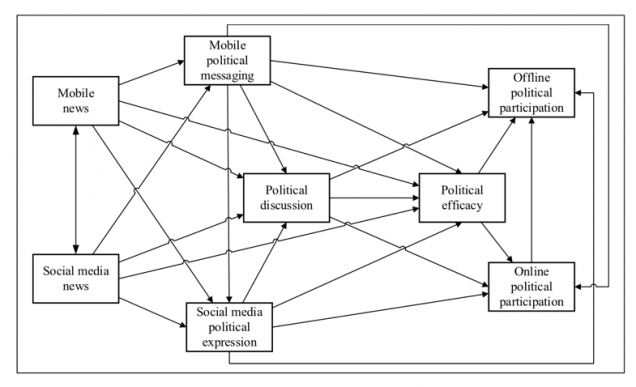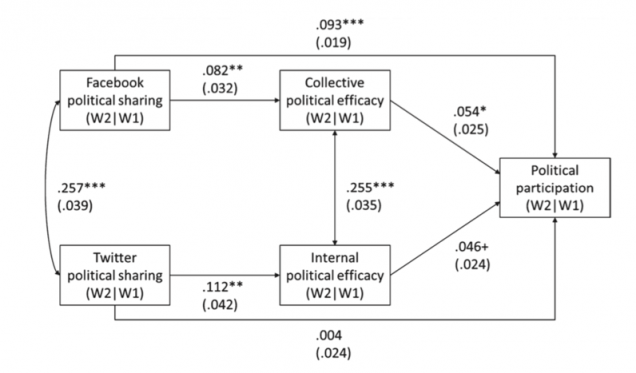Everything has been changed hugely by mobile and social media, so do the politic sphere. The newer media system consisting of mobile phones(e.g. anytime anywhere access to information and messaging)and social media (e.g. online linkages through networks of individuals and groups) is interacted with the older media systems complicatedly both within and across the field, forming the “hybrid media system”. According to Chadwick, the Power in the hybrid media system should be understood as “the use of resources of varying kinds, which in any given context of dependence and interdependence enable individuals or collectivities to pursue their values and interests, both with and within different but interrelated media.” (Chadwick, 2017)
Chan’s paper helped us to furtherly figure out what exact variables, and how they interrelate with each other. They have done a cross-national study design to comparatively examine the relationships among the mobile media, social media use, and political participation by using the O-S-R-O-R model. (Orientation- Stimulus – Reasoning – orientation – response).

Based on the model above, it specifically demonstrates the relationship between news media use (S) (Mobile and social media) and participation (second R) (consisting of online and offline political participation), which was mediated by both interpersonal political discussion (first R) (Consisting of mobile political messaging, social media political expression, and political discussion) and internal political efficacy (second O). The result shows that media → communication→ online participation pathway comprised the largest proportion of the effect sizes. Moreover, there is a robust relationship between online and offline political participation. participatory experiences and activities engaged in online settings first may give them more motivation, confidence, and opportunities to engage in traditional forms of political participation offline.
Except for the various mediators between the mobile or social media use and political participation, the various mobile user behavior patterns would influence the political participation. According to Hua Ping, there are four main patterns of mobile media practice: Text messaging, mobile blogging, voice calling and news reading. In her studies, the direct relationship between different patterns of mobile phone use and political expression among young Chinese students was examined by hierarchical regression analysis, which is also applied to predict the political participation.
The results showed that:
- more respondents read news delivered on the screen of the mobile phone and the more they send or post microblogs via mobile phone, the more frequently they would like to express personal opinions and perspectives, whose direct effects on offline political participation is also significant and works through the mediator, the online political expression.
- However, the frequency of text messages has a negative influence on political expression, which could be explained by that the young people are usually texting on mobile for entertainment, which would reduce the levels of politic expressions. (Chan et al., 2012; Zhang and Lin, 2014).
- Lastly, she proved that the more the respondents expressed their political opinion via mobile phone, the more often they engaged in offline political participation.
Not only do the mobile use patterns matter with the extension of political expressions and participation but also different social media platforms would influence political participation. Daniel Halpen illustrates that the frequent use of Facebook and Twitter for sharing political information is conducive to higher levels of participation through different efficacy measures.
Efficacy, one important measure or factor possibly resulting in political participation, need to be articulated here, which has also been used as one important mediator variable in the above articles. Efficacy could be understood as the feeling that an individual citizen can play a part in affecting political and social change (Campbell et al., 1954). It could be broken down into three sub-concepts, internal efficacy, external efficacy, and collective efficacy. For the studies done by Daniel Halpen, both the internal efficacy (refers to an individual’s belief about her competence to understand and to participate actively in politics) and collective efficacy (also refers to individual perceptions but, in contrast to internal efficacy, the target of these perceptions is the group that the individual feels a part of) play an important role for demonstrating the differences of effect of Twitter and Facebook on political participation as a mediator factor. However, different platforms are influencing online political participation through different categories of efficacy as shown in figure 2.

It shows that both internal efficacy and collective efficacy had independent, positive associations to participation. However, political sharing on Facebook influenced political participation directly, that is, independent of its effect on collective efficacy. On the other hand, Twitter was only through internal efficacy that sharing on Twitter mattered for political behavior.
Except for the mobile using patterns and social media platform, another factor, network characteristics (size and heterogeneity), is also considered by Scott W. In his article, network size is defined as those who you feel very close to and with whom you are frequently in contact to discuss various things, including your personal issues and feelings’. Heterogeneity is estimated by two items: Respondents were asked to report how many of the people in their network of strong personal ties shared their political views and how many supported the same presidential candidate as the respondent. The study reveals that Participation increases with use of the technology in large networks of like-minded individuals, but declines with use of the technology in homogeneous networks that are small. The political participation or expression within large networks of like-minded individuals may increase the extent of polarization.
Based on the discussions above, we realize the small word, mobile or social media, could influence the political sphere through various mediators. The newer media system of openness and fluidity is changing the attitudes, expression, and participation of politic of people, especially young people. The new logic of circulation, recirculation, and negotiation is interacting with the older media system of transmission and receptions, conducting a more expansive and inclusive political communication than those that prevailed during the twentieth century.
Citation:
Campbell, S. W., & Kwak, N. (2011). Political Involvement in “Mobilized” Society: The Interactive Relationships Among Mobile Communication, Network Characteristics, and Political Participation. Journal of Communication, 61(6), 1005-1024. doi:10.1111/j.1460-2466.2011.01601.x
Pang, H. (2018). Mobile communication and political participation: Unravelling the effects of mobile phones on political expression and offline participation among young people. International Journal of Electronic Governance, 10(1), 3. doi:10.1504/ijeg.2018.091262
Halpern, D., Valenzuela, S., & Katz, J. E. (2017). We Face, I Tweet: How Different Social Media Influence Political Participation through Collective and Internal Efficacy. Journal of Computer-Mediated Communication, 22(6), 320-336. doi:10.1111/jcc4.12198
Chan, M., Chen, H., & Lee, F. L. (2016). Examining the roles of mobile and social media in political participation: A cross-national analysis of three Asian societies using a communication mediation approach. New Media & Society, 19(12), 2003-2021. doi:10.1177/1461444816653190
Chadwick, A. (2017). The hybrid media system: Politics and power. New York, NY: Oxford University Press.